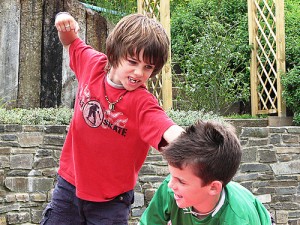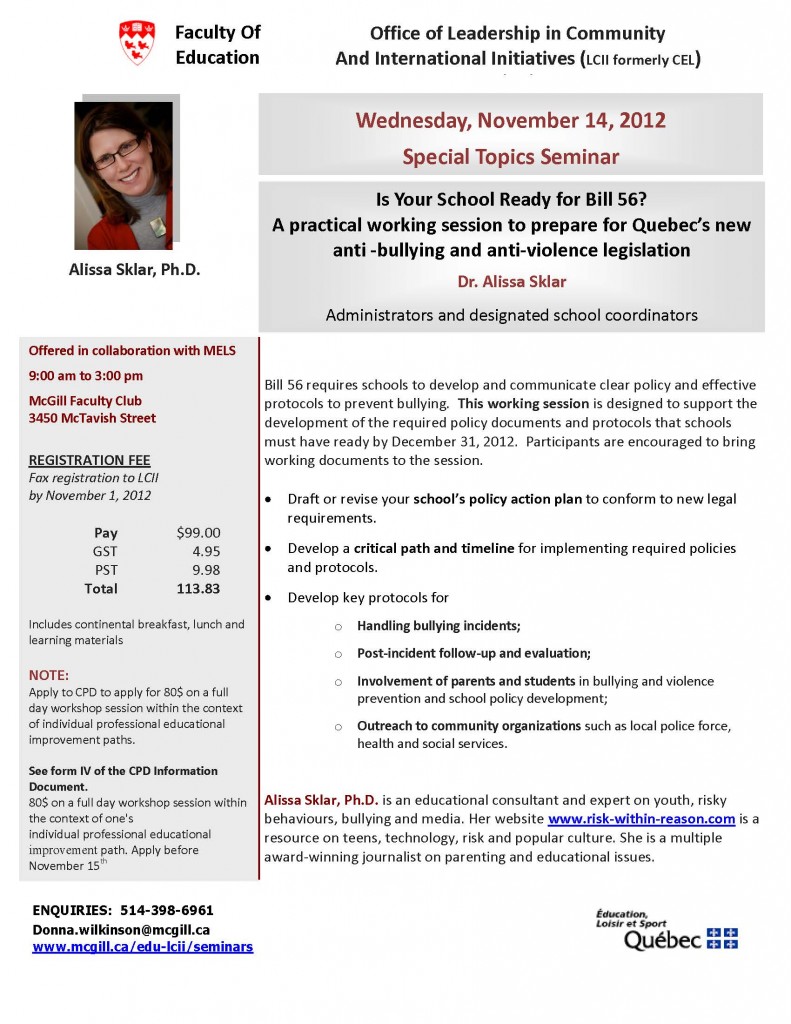 There are many terrible lessons to be learned from the tragic suicide of 17-year-old Nova Scotia teenager Rhetea Parsons, but one in particular jumped out at me. I was struck by what seemed to be the complete failure of her high school to support her in the wake of the sexually explicit pictures (depicting her alleged rape) circulated in the community.
There are many terrible lessons to be learned from the tragic suicide of 17-year-old Nova Scotia teenager Rhetea Parsons, but one in particular jumped out at me. I was struck by what seemed to be the complete failure of her high school to support her in the wake of the sexually explicit pictures (depicting her alleged rape) circulated in the community.
First, a little context: in 2011, Rheteah Parsons said she was raped by four teenage boys at a house party. The circumstances of that event is the topic of another blog post to come, and many have written about what seems to be disinterested or haphazard police investigation that resulted in charges eventually being dropped.
In the aftermath of the alleged sexual assaults, the boys distributed cellphone photos of the attack, depicting (according to reports) Rheteah vomiting while being assaulted and at least one of the boys was shown smiling and giving the camera a thumbs up during sexual interactions. These photos got passed all over the school, and Rheteah was branded a slut and bullied viciously by her peers.
When the distraught teenager killed herself last week, her father attributed it to “disappointment,” not rape or bullying. Rheteah Parsons appears to have been let down by all of the institutions around her charged with her safety: her school, her community, the system of law and order.
In a digital world, the stakes and politics of bullying are magnified exponentially. The Cole Harbour, NS high school attended by Rheteah failed miserably. There are a number of things any school must do when these kinds of sexual images of students are distributed, because the students depicted (almost always girls) are extremely vulnerable to repeated bullying, coercion, blackmail and assault. (Click to tweet this.)
Those kinds of sexual images almost always put the kids at risk. From classmates. From kids at other schools. From complete strangers on the Internet.
In this new normal, it isn’t enough to sensitize kids to bullying or Internet safety. We need to talk to them about sexting. About slut-shaming. About how to respond to a peer who has suffered the indignity of having those kinds of pictures spread online. Ideally, this should begin with prevention initiatives to help them understand what it’s all about.
The Canadian Centre for Child Protection has created an excellent Resource Guide for Parents who are dealing with this kind of sexual exploitation of their children, whether their kids posted the pictures themselves or had peers do it. Click on the link to download it as a PDF. You can also view a short video about this issue here. Cybertips.ca also offers this well-written guide for kids who are dealing with sexual images online, whether it’s for themselves or a friend.
This resource guide also has excellent advice for parents of kids who perpetrate this kind of sexual exploitation of others by disseminating these images or commenting on them in anti-social ways.
All parents should look this over, whether your kids have been impacted or not.
Parent responses to the sexual exploitation of their kids online
- Reassure your child.
- Engage in fact-finding, but don’t feel the need to view the content. Your child may already by humiliated and horrified by its dissemination, and knowing their parent has seen it may make it even worse.
- Explore the steps the school can take. This will depend on whether the other parties involved are students. They can also assist in having the images deleted.
- Address content of concern, and take steps to have it removed. The Resource Guide walks you through steps on how to do this.
- Keep your child abreast of what is happening and collaborate in a plan for moving forward. They need to feel they are part of the solution.
- Outline with your child the consequences for their behaviours if they were involved in the production or dissemination of the content. This may include restricting Internet and cellphone use.
- Help them identify sympathetic and supportive friends. This is too much to deal with all alone.
- Create a safety plan with the school. At very least, they can sensitize the other students and be vigilant for follow-up bullying or harassment.
- Seek professional help as needed. Familiarize yourself with signs of depression and anxiety. The fallout from this kind of incident can be very long-term.
Guidelines for schools in dealing with sex-related bullying/ harassment.
- These students may be traumatized. They may need a plan to effectively deal with the emotional turmoil and practical fallout. Discuss with these students possible sources of strength such as family support, friends, community support, healthy activities, and counseling.
- Help the target plan a “next steps” strategy to tap into these sources.
- Make sure the student also knows to report any continuing challenges.
- Periodically check in with the student to find out how things are going. Also contact the student’s teachers to ask them to be attentive to any concerns.
- In any situation where a student has had a nude image distributed, It is essential to predict sexual harassment and have a plan of action to prevent and intervene. This will require ongoing, intensive support of the student depicted.
- Respond to reports of harassment in a manner that is restorative and that also sends a clear message that such harassment will not be tolerated.
- Help this student enlist the help of supportive friends. Speak with the friends of this student to ask them to report to the school if problems continue or the student is showing signs of continuing distress.
More information for school personnel on dealing with this issues can be found in another resource guide, also developed by the Canadian Centre for Child Protection. School and Family Approaches to Intervention and Prevention: Addressing Self/ Peer Exploitation can be ordered by clicking here.
We need to do this better. For Rheteah. For Amanda. For Audrie. For all the other girls and boys who have been victimized in this way.



